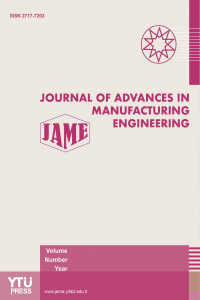Abderrazak ALLALI, Mouloud AISSANI, Nadir MESRATI, Boubaker OTHMANI, Mihoub MEDKOUR, Ishaak BOUKHADOUNI
Experimental, Mechanical Characterizations of Friction Welding of Steel and Aluminium Joints
Experimental, Mechanical Characterizations of Friction Welding of Steel and Aluminium Joints
Rotary friction welding (RFW) is a solid-state joining process which works by rotating one workpiece relative to another while under a compressive axial force, which produces coalescence of materials workpieces. It is considered most viable alternative to overcome the difficulties faced in conventional joining techniques. As it is a solid state welding process, the process does not form molten pool thereby eliminating the solidification errors. It offers many advantages for some manufacturing sectors for a wide range of applications. In this research, we investigated the mechanical and metallurgical characteristics of RFW welded joints for homogenous and heterogeneous assemblies. We have studied A60 steels and 2017A series aluminum alloys. The obtained welds are similar in appearance in that they have several Microstructural distinct zones. So, the results show that by increasing the rotating speed employing 1000 and 1600 rpm, the mechanical properties during the RFW process is lightly improved, favored by the increase in heat flow. In the same specimen, the micro hardness distribution is generally viewed lightly changed between center line throw weld of welded tube and close to their boundary line. This is due to the no-uniform of temperature distribution in cross section. Thus, plastic deformation of heated portion of the metal plays an important role in friction welding process and their quality. Microstructural analysis reveals that grain growth in the joint WCZ and in heat affected zone HAZ because of the no-uniform of thermal flux distribution in both directions (transvers and longitudinal of tube). Finally using RFW, the fabricators allow to perform and maintenance the mechanical components with low cost and which it conserves their welding quality compared to the classical fusion welding
Keywords:
Rotary Friction Welding (RFW), Plasticized Material, Heat Flux, Characterization, Microhardness,
___
- [1] Shete, N., & Deokar, S.U. (2017). A Review Paper on Rotary Friction Welding, International Conference on Ideas, Impact and Innovation in Mechanical Engineering (ICIIIME 2017), 5(6), 1557 – 1560.
- [2] Imani, Y., Guillot, M., & Tremblay, A. (2014). Optimization of FSW tool design and operating parameters for buttwelding of AA6061-T6 at right angle. Proceedings of the Canadian Society for Mechanical Engineering International Congress.
- [3] Liu, H. J., Fujii, H., & Nogi, K. (2004). Microstructure and mechanical properties of friction stir welded joints of AC4A cast aluminium alloy. Materials Science and Technology, 20(3), 399-402.
- [4] Genevois, C. (2004). Genèse des microstructures lors du soudage par friction malaxage d’alliages d’aluminium de la série 2000 et 5000 et comportement mécanique résultant. PhD thesis, INPG.
- [5] Aissani, M., Gachi, S., Boubenider, F., & Benkedda, Y. (2010). Design and Optimization of Friction Stir Welding Tool. Materials and Manufacturing Processes, 25(11), 1199-1205.
- [6] Barralis, J., & Maeder, G. (2005). Les précis AFNOR/Nathan. Métallurgie, élaboration, structures-propriétés, normalisation, collection. (ISBN 978-2-09-179582-9).
- [7] Hantcherli, M. (2010). Influence d’éléments d’addition sur les transformations de la martensite revenue dans les aciers faiblement alliés. Thèse Doctorat de l’École Nationale Supérieure des Mines de Saint-Étienne. France.
- [8] Adel, M. (2008). Effet des additifs sur la microstructure et les propriétés mécaniques des alliages d'aluminium-silicium. Thèse de doctorat, Université du Québec à Chicoutimi.
- [9] Philibert, J., Vignes, A., Bréchet, Y., & Combrade, P. (2013). Métallurgie. Du minerai au matériau, Technique et ingénierie / Mécanique et matériaux. Paris, Dunod, coll. 2ndéd.
- ISSN: 2717-7203
- Başlangıç: 2020
- Yayıncı: Yıldız Teknik Üniversitesi
Sayıdaki Diğer Makaleler
Analyzing Optimum Process Parameters in Laser Cutting of EN10025-2 Steel Plate
Research of Treatment Process of Conical Holes by Diamond Honing
Experimental, Mechanical Characterizations of Friction Welding of Steel and Aluminium Joints
Abderrazak ALLALI, Mouloud AISSANI, Nadir MESRATI, Boubaker OTHMANI, Mihoub MEDKOUR, Ishaak BOUKHADOUNI
Influence Structures of The Machine Tools on Roughness in Turning
Nabil KRİBES, Ouelaa NOUREDINE, Yallesse Med ATHMANE, Mabrouki TAREK
Investigation of Chip Breaker and Its Effect in Turning Operations
